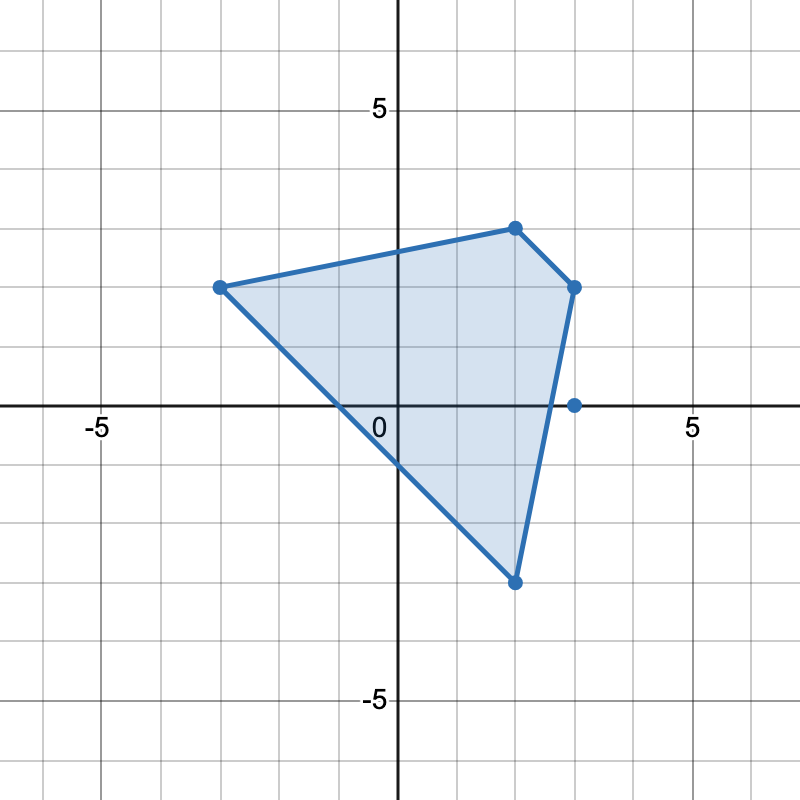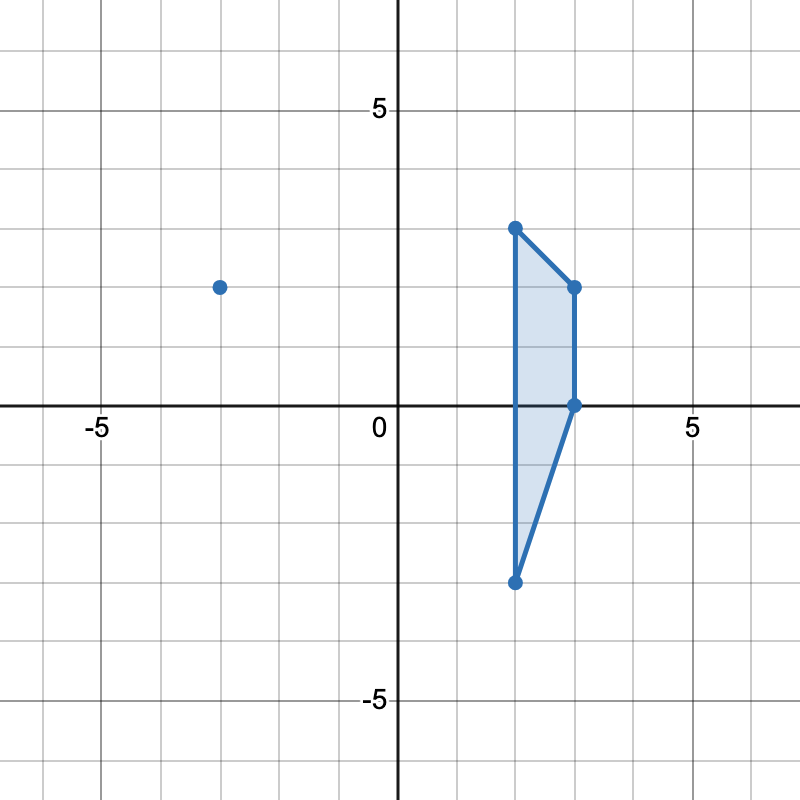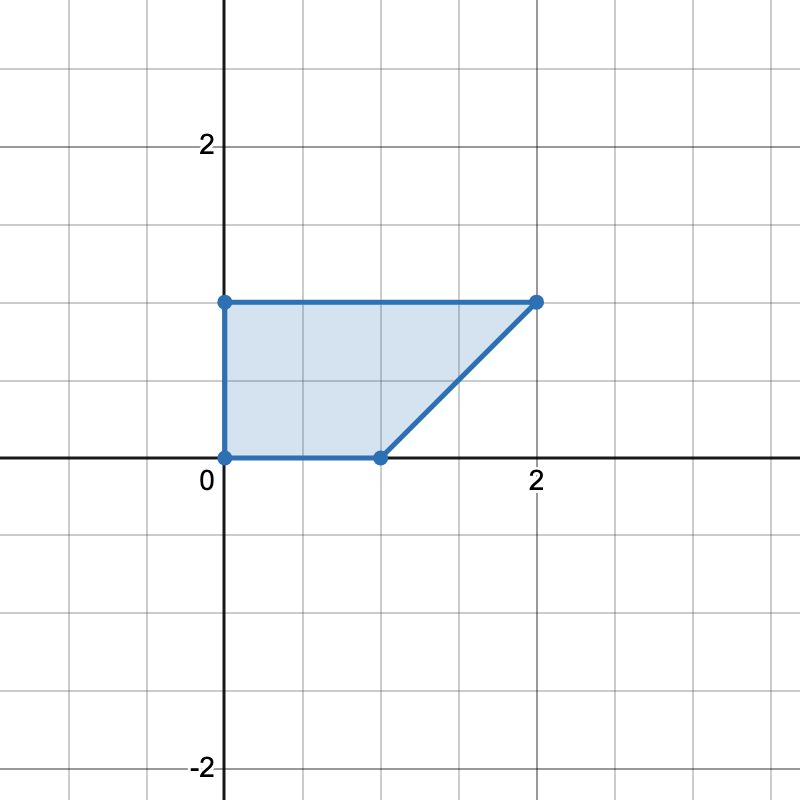LeetCode-in-Java
3625. Count Number of Trapezoids II
Hard
You are given a 2D integer array points where points[i] = [xi, yi] represents the coordinates of the ith point on the Cartesian plane.
Return the number of unique trapezoids that can be formed by choosing any four distinct points from points.
A trapezoid is a convex quadrilateral with at least one pair of parallel sides. Two lines are parallel if and only if they have the same slope.
Example 1:
Input: points = [[-3,2],[3,0],[2,3],[3,2],[2,-3]]
Output: 2
Explanation:


There are two distinct ways to pick four points that form a trapezoid:
- The points
[-3,2], [2,3], [3,2], [2,-3]form one trapezoid. - The points
[2,3], [3,2], [3,0], [2,-3]form another trapezoid.
Example 2:
Input: points = [[0,0],[1,0],[0,1],[2,1]]
Output: 1
Explanation:

There is only one trapezoid which can be formed.
Constraints:
4 <= points.length <= 500–1000 <= xi, yi <= 1000- All points are pairwise distinct.
Solution
import java.util.HashMap;
import java.util.Map;
public class Solution {
private static class Slope {
int dx;
int dy;
Slope(int dx, int dy) {
this.dx = dx;
this.dy = dy;
}
@Override
public boolean equals(Object o) {
if (this == o) {
return true;
}
if (!(o instanceof Slope)) {
return false;
}
Slope s = (Slope) o;
return dx == s.dx && dy == s.dy;
}
@Override
public int hashCode() {
return dx * 1000003 ^ dy;
}
}
private static class Pair {
int a;
int b;
Pair(int a, int b) {
this.a = a;
this.b = b;
}
@Override
public boolean equals(Object o) {
if (this == o) {
return true;
}
if (!(o instanceof Pair)) {
return false;
}
Pair p = (Pair) o;
return a == p.a && b == p.b;
}
@Override
public int hashCode() {
return a * 1000003 ^ b;
}
}
public int countTrapezoids(int[][] points) {
int n = points.length;
Map<Slope, Map<Long, Integer>> slopeLines = new HashMap<>();
Map<Pair, Map<Slope, Integer>> midpointSlopes = new HashMap<>();
for (int i = 0; i < n; i++) {
int x1 = points[i][0];
int y1 = points[i][1];
for (int j = i + 1; j < n; j++) {
int x2 = points[j][0];
int y2 = points[j][1];
int dx = x2 - x1;
int dy = y2 - y1;
int g = gcd(Math.abs(dx), Math.abs(dy));
dx /= g;
dy /= g;
if (dx < 0 || (dx == 0 && dy < 0)) {
dx = -dx;
dy = -dy;
}
int nx = -dy;
int ny = dx;
long lineId = (long) nx * x1 + (long) ny * y1;
Slope slopeKey = new Slope(dx, dy);
slopeLines
.computeIfAbsent(slopeKey, k -> new HashMap<>())
.merge(lineId, 1, Integer::sum);
int mx = x1 + x2;
int my = y1 + y2;
Pair mid = new Pair(mx, my);
midpointSlopes
.computeIfAbsent(mid, k -> new HashMap<>())
.merge(slopeKey, 1, Integer::sum);
}
}
long trapezoidsRaw = 0;
for (Map<Long, Integer> lines : slopeLines.values()) {
if (lines.size() < 2) {
continue;
}
long s = 0;
long s2 = 0;
for (Integer line : lines.values()) {
s += line;
s2 += (long) line * line;
}
trapezoidsRaw += (s * s - s2) / 2;
}
long parallelograms = 0;
for (Map<Slope, Integer> mp : midpointSlopes.values()) {
if (mp.size() < 2) {
continue;
}
long s = 0;
long s2 = 0;
for (Integer num : mp.values()) {
s += num;
s2 += (long) num * num;
}
parallelograms += (s * s - s2) / 2;
}
long res = trapezoidsRaw - parallelograms;
return res > Integer.MAX_VALUE ? Integer.MAX_VALUE : (int) res;
}
private int gcd(int a, int b) {
while (b != 0) {
int t = a % b;
a = b;
b = t;
}
return a == 0 ? 1 : a;
}
}

